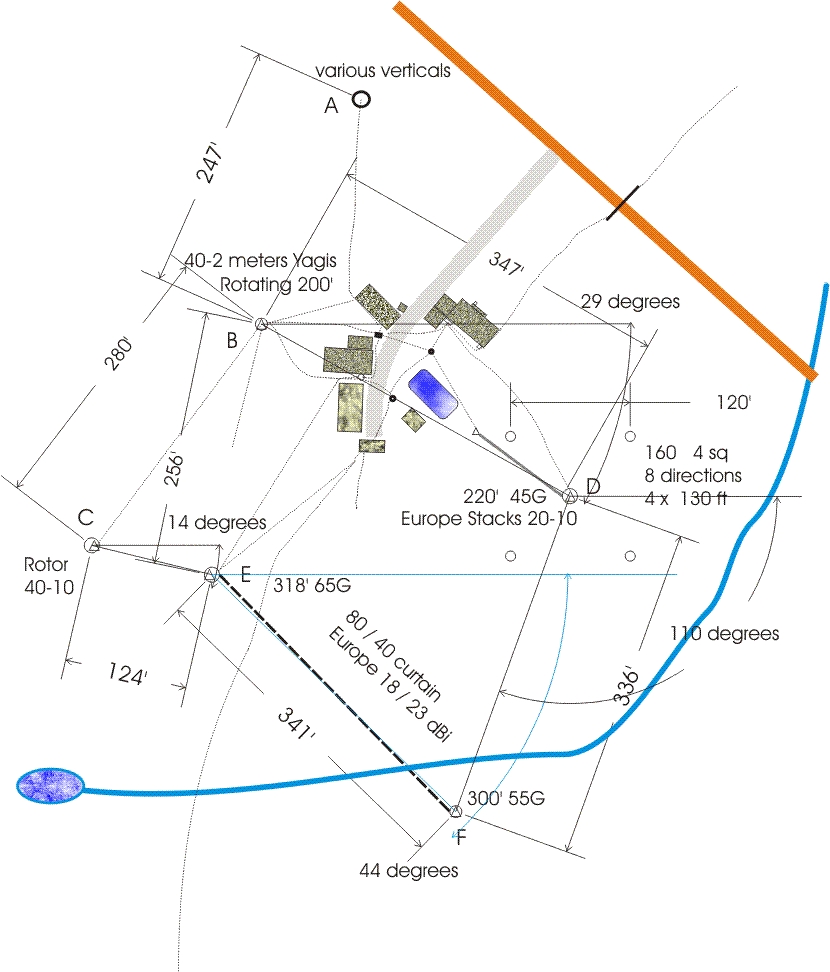W8JI Contest Station
Also see:
45G tower page
Rotating Tower
page
Antenna System and
my house station
A ground will not….
My grounding…..
|
W8JI Location
My station is located in middle-Georgia, just off I-75, in grid EM73XB and
Lamar County.
It is a rural agricultural location with few local power lines, the nearest
high tension lines are miles away.
Basic overall property showing antenna layout:
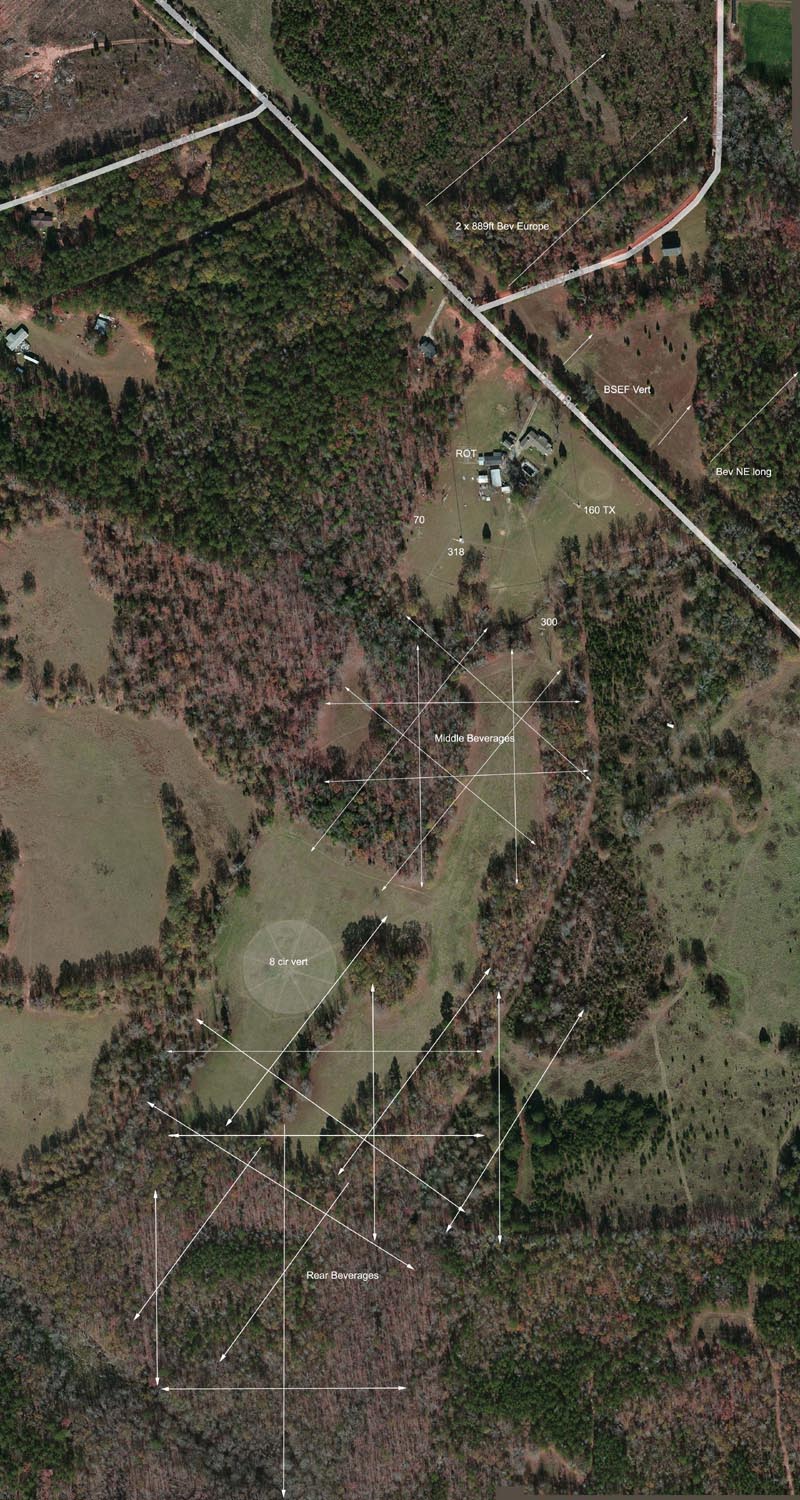
Transmitting Antennas
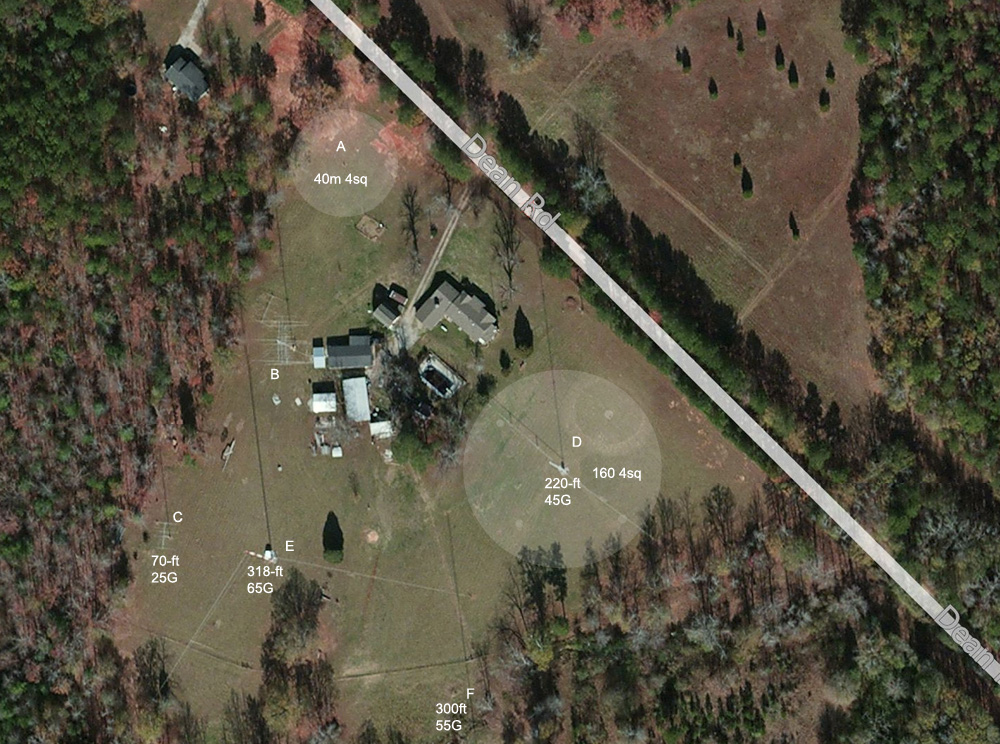
Underground control wire and feed line routing.
Tower position and spacing.
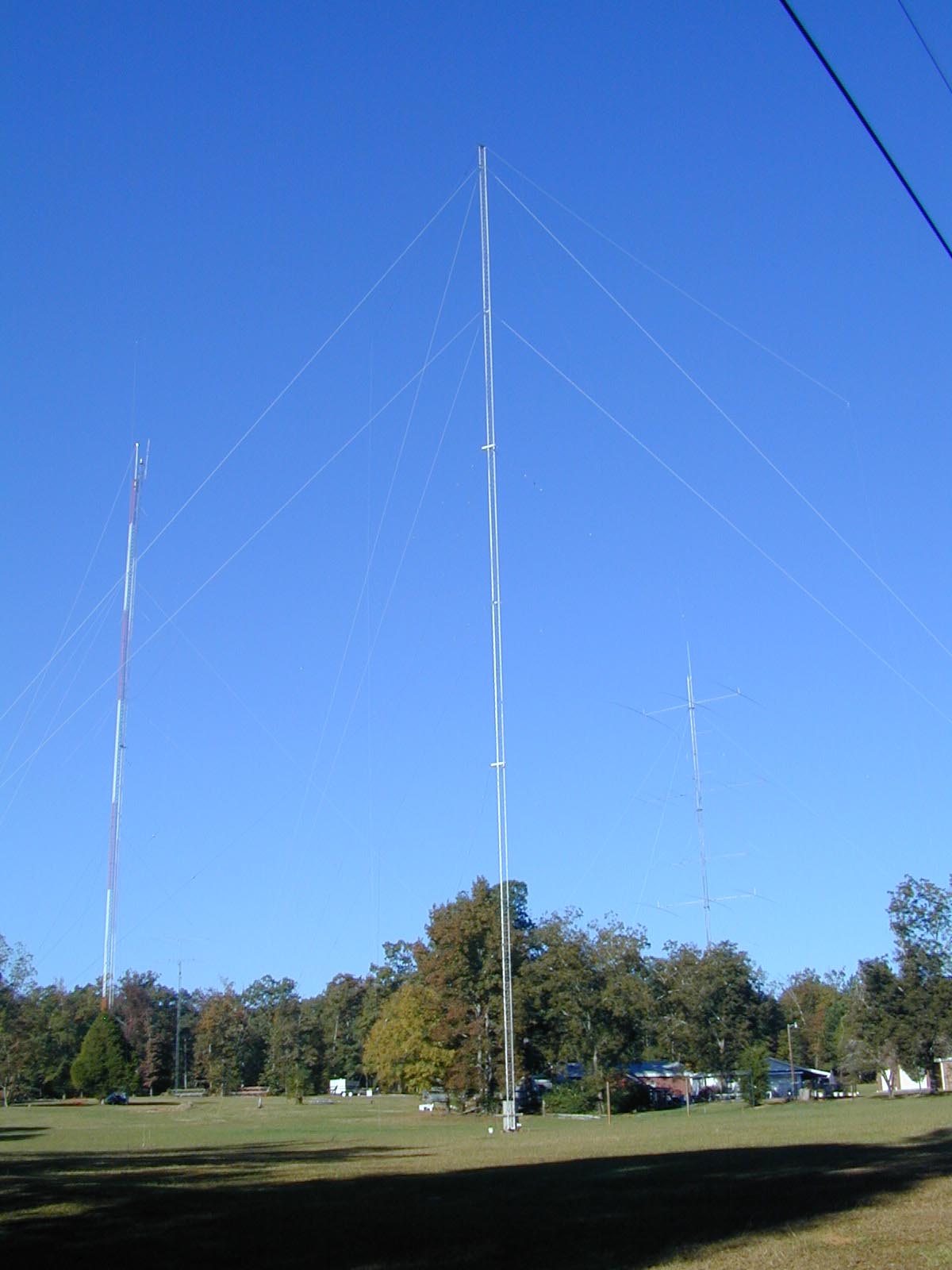
Left-to-right 318ft 65G, 70-ft
25G background, 200-ft 45G foreground,
200-ft rotating background
Cable Entrance
and routing
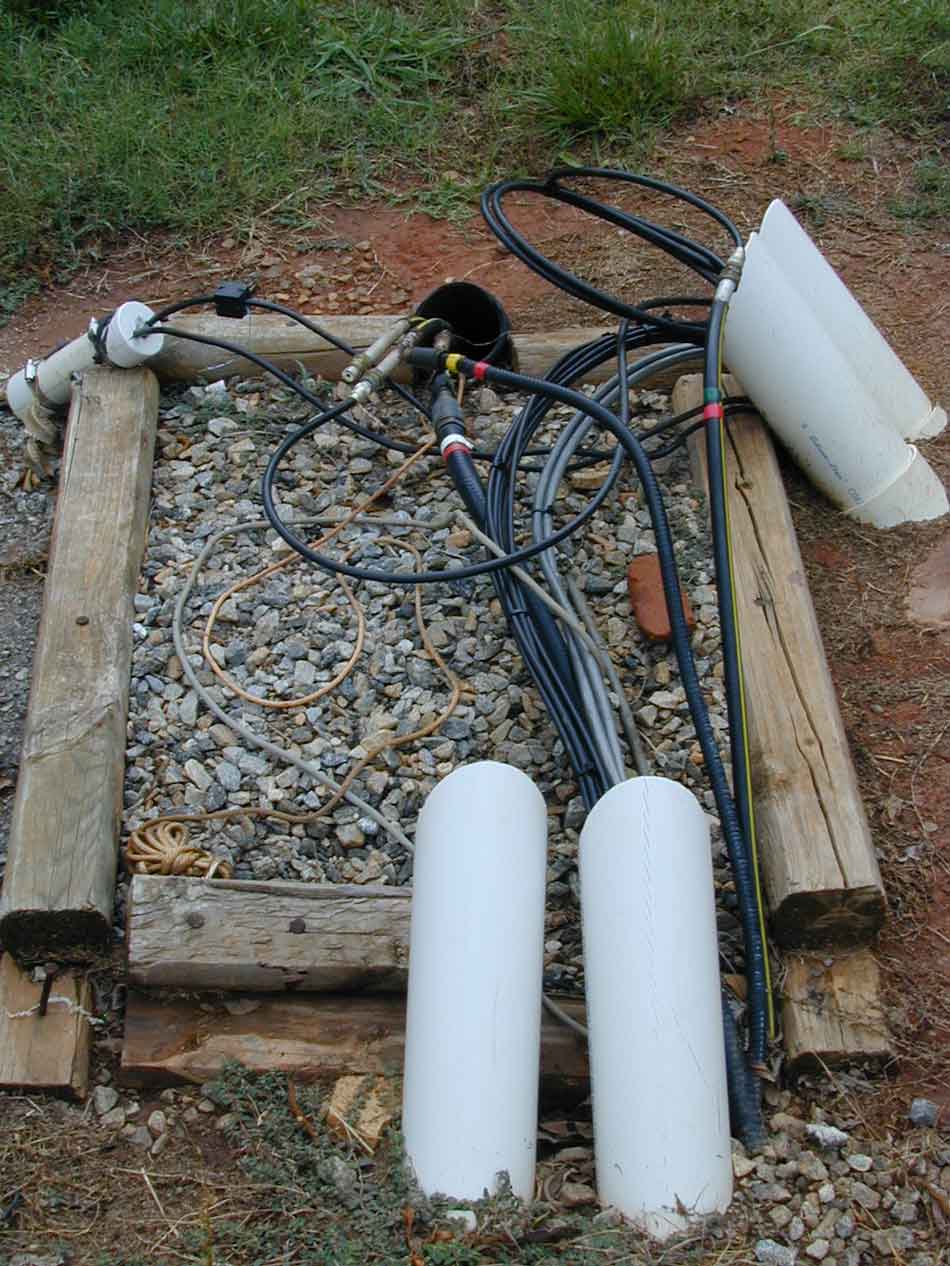
Cables and conduits arrive from different directions at connection islands.
New cables are easily installed through 4-inch
diameter pipes, either flexible black drain pipe or PVC. All pipes
have drain holes and gravel at
low spots
for drainage.
I try to
keep receiving
and control cables
in one pipe and
transmitting cables
in the other pipe, mostly to make wiring easier to follow. I find very little
electrical advantage.
I use tape “color codes”
to keep track of
cables.
Some cables are directly buried under
the pipes.
All transmitting
cables are 50-ohm,
all receiving cables
75-ohm. The
large hardline
and heliax cables in this photo are all 50-ohm.
The red/green
taped cable with the
yellow stripe is a
flooded aluminum
jacket CommScope “50-ohm power
cable”. In the event the jacket is cut, flooding compound
between the jacket
and shield re-seals
the cable. This cable has a
very large solid-copper center, and
the shield is .625 inches OD. It is
very tough cable, suitable for direct
burial. I have about 1,500 feet of it in my transmitting system.
Other cables, like the red/white and red/yellow marked cables, are
traditional heliax. Solid copper jacket heliax can be directly buried. Most of
this cable has been pulled from Cell and Two-way towers. The average price for
good used heliax cable is about 75-cents per foot.
The silver cables
are control cables.
Each control cable has 44 shielded conductors.
The smallest black cables are F-6 type cables, for receiving. They are
single-foil single-braid flooded cables, and offer unnoticeable leakage or crosstalk over
HF. By far, connectors and interface designs have far more influence on leakage.
The two black
cables entering the
hose-clamped white PVC “pipe box” are
telephone cables.
All HF connectors are
large DIN connectors or
UHF-type fittings. N-connectors are only used for upper VHF and UHF
wiring. This is
because standard
UHF male and female
(PL-259 or SO-239) connectors have much higher
current and voltage
breakdown than
type-N connector. A typical Teflon UHF pair, properly installed, will handle at
least 5kV in a high-pot test. They will also handle 10-15 amperes RF current
through the large center pins. While less weather resistant than type-N
connectors, UHF fittings are much
more reliable in systems with lightning or high-power SWR issues.
The two large
white pipes at the
bottom run under the
driveway to another
collection point in
a recessed hole. Rather than thin wall or flex drain pipe, I use a more rigid schedule 40
PVC pipe under the drive.
Manhole
Across the
driveway, the white
pipes enter a yard area. This ruled out using an above ground island. I used
a plastic feed storage container and large corrugated pipe drain cleanout as a
makeshift
double-walled manhole. Rock in the
bottom promotes
drainage. This view
is after
more than 1 inch of
rain from a severe
thunderstorm, and the hole bottom is only moist!
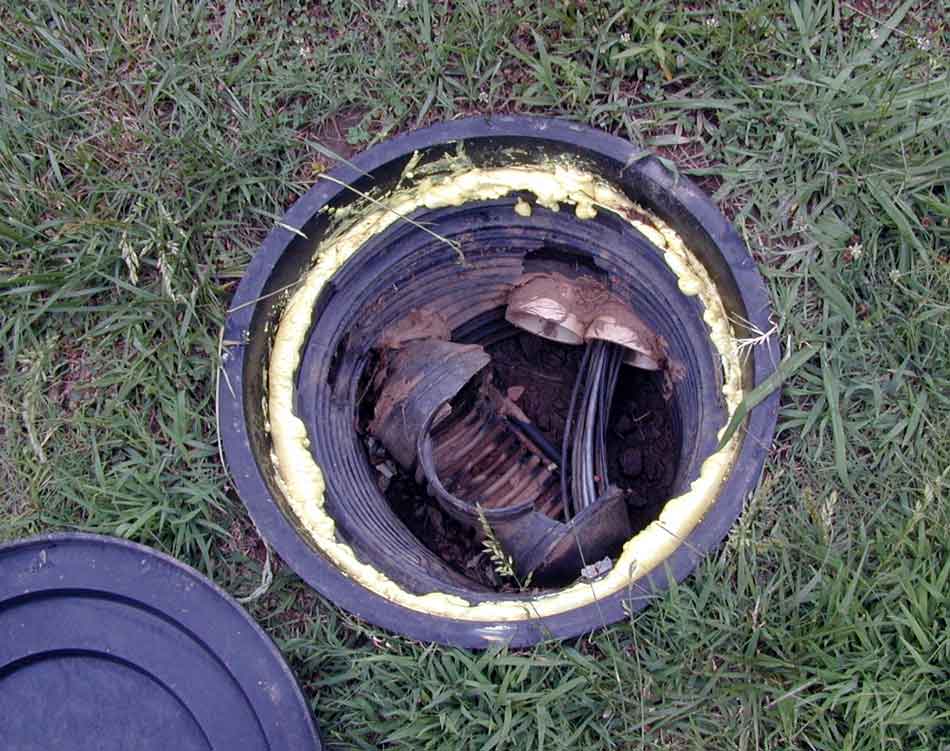
Note the large
corrugated drain pipe cut-away T.
This pipe runs between the 318-foot
tower, about 350 feet away, and
the house.
Although barely visible in the picture, there are many 50-ohm Heliax,
control, and 75-ohm hardline cables under the pipes. These cables feed other antennas, like receiving antenna systems
behind the house area.
The house serves as
a collection point
for receiving
antennas and cables
from my 200-foot
tower, while most newer antenna towers and feed lines route into the contest barn.
When
covered the manhole
looks like this:
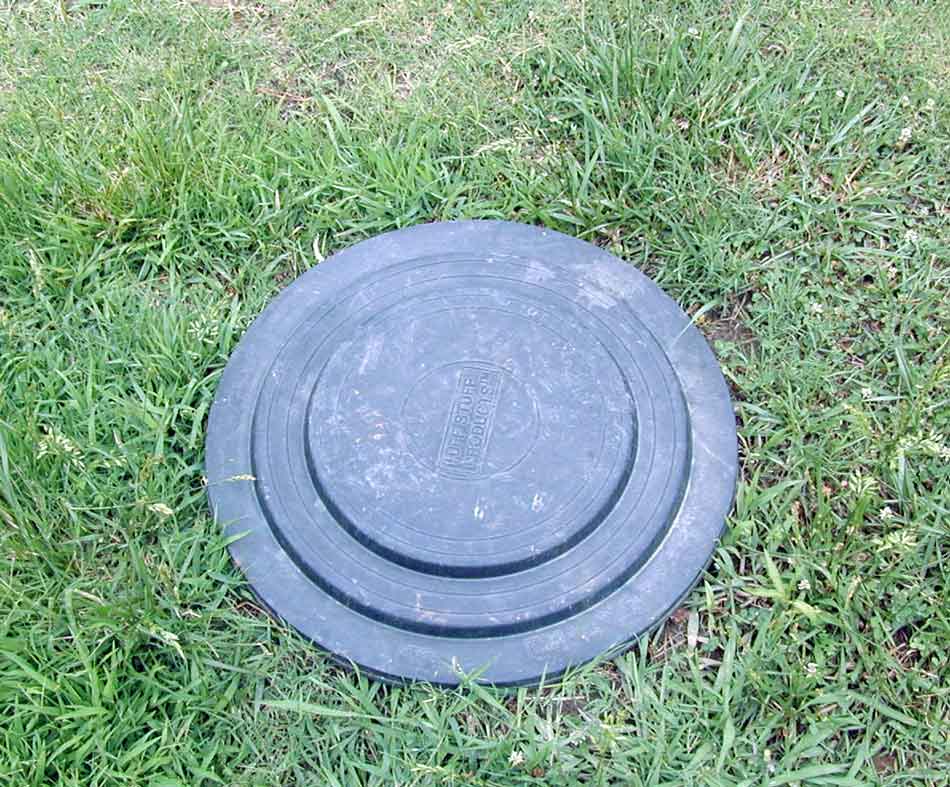
Cover in place
hides wiring and
keeps out water.
There are other
cables arriving at
the new building.
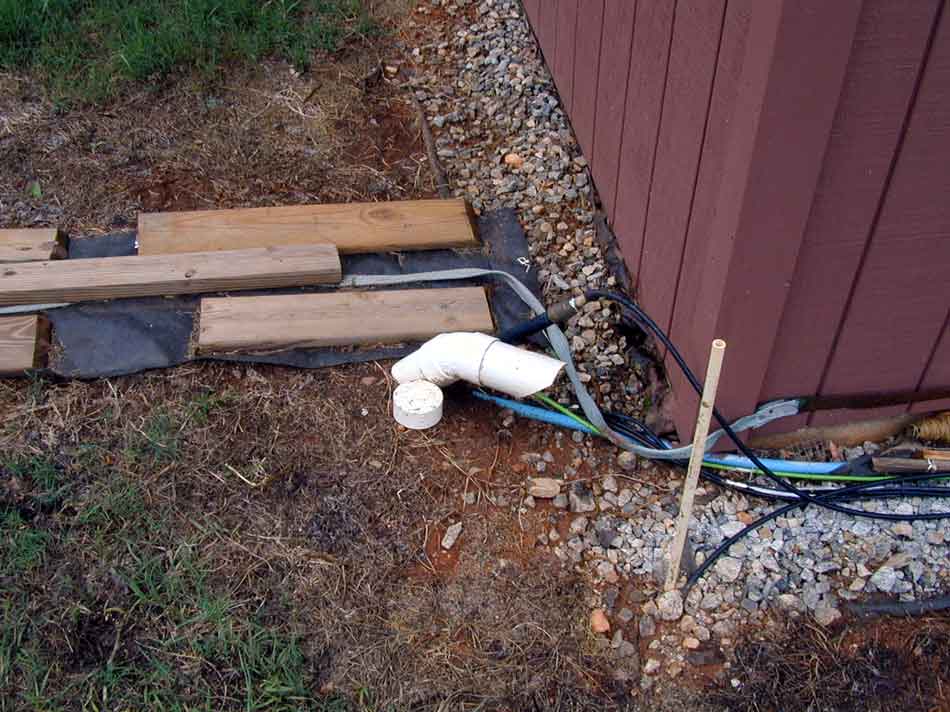
This feed goes to
the north end of the
property, to the area of the 40 meter foursquare. Several direct
burial telephone,
control, 50-ohm Heliax, and 75-ohm
cables are buried
under
the conduit. The
conduit allows for
easy future
expansions and
protects the
directly-buried
cables. There is a
vertical access
point every 100
feet. The little
vertical PVC pipe
marks an F-11 style direct-burial
receiving cable. That F-11 style cable runs 3000-feet to the very rear southwest corner of
my property. It is primarily used for experimental or trial receiving antennas. It has access points every 500-feet.
Contest Barn Cable Entrance
I use an open panel entrance scheme. 2 oz copper G10 double-sided circuit
board, mounted on plywood, provides a large groundplane for mounting terminal
blocks and switches.
- Every wire and cable, which includes power lines, control lines, remote
metering lines, and RF cables, enter the barn via this common
ground connection point - Small cables are
F6 style CommScope aluminum foil-and-braid 75-ohm receiving antenna cables - Large RG213/U and LMR400 cables are used for transmitter wiring
- The row of
vertically oriented
white terminal
blocks are 68 control
line wires. These wires and blocks are replicated and parallel connected
pin-by-pin at several points in my
system, including the house “wire hider”. This allows all control lines
to
be accessed at several important points in my system - Entrance board is bonded to the electrical entrance panel.

Relay switches
above can be quickly
patched in, or added in with steering diodes. This flexibility allows creation
of rapid customized radio setups
in the operating room. Four RG-213/U transmitting antenna
cables come down
from the operating room.
Over sixteen RF trunk cables
exit to various
towers or antenna
locations.
| System | 70 ft with rotor | 315 ft Rohn 65G |
200 ft
Rohn |
Rotating tower | Vertical Group | Dipoles |
|
Number trunk cables |
2 | 4 | 4 | 3 | 1 | 2 |
All wires are documented on a list:
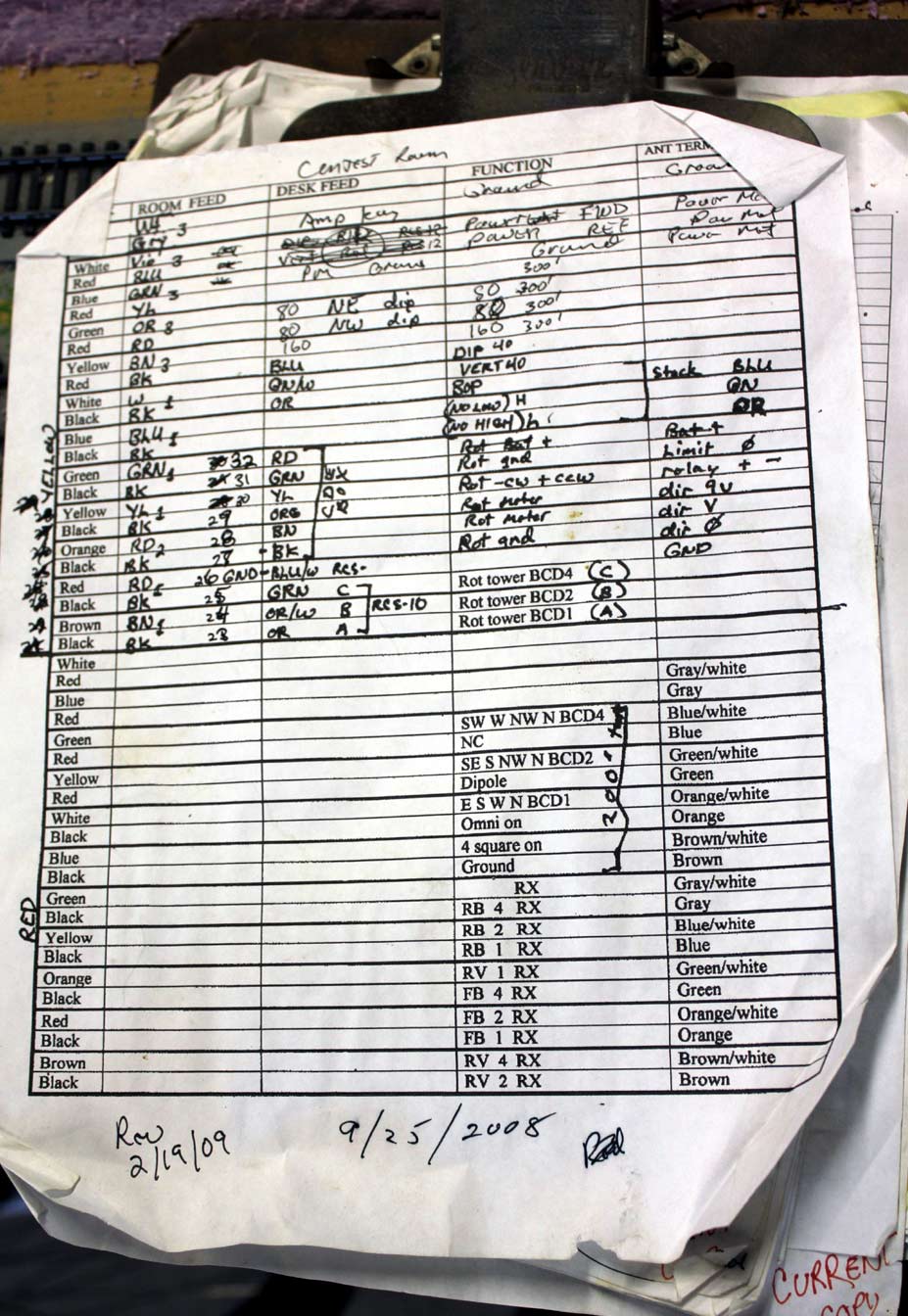
control requirement to an appropriate desk switch and every power supply or
computer lead to equipment on an under-desk shelf. You can see this on desk
pictures if you look for little painted wood blocks.
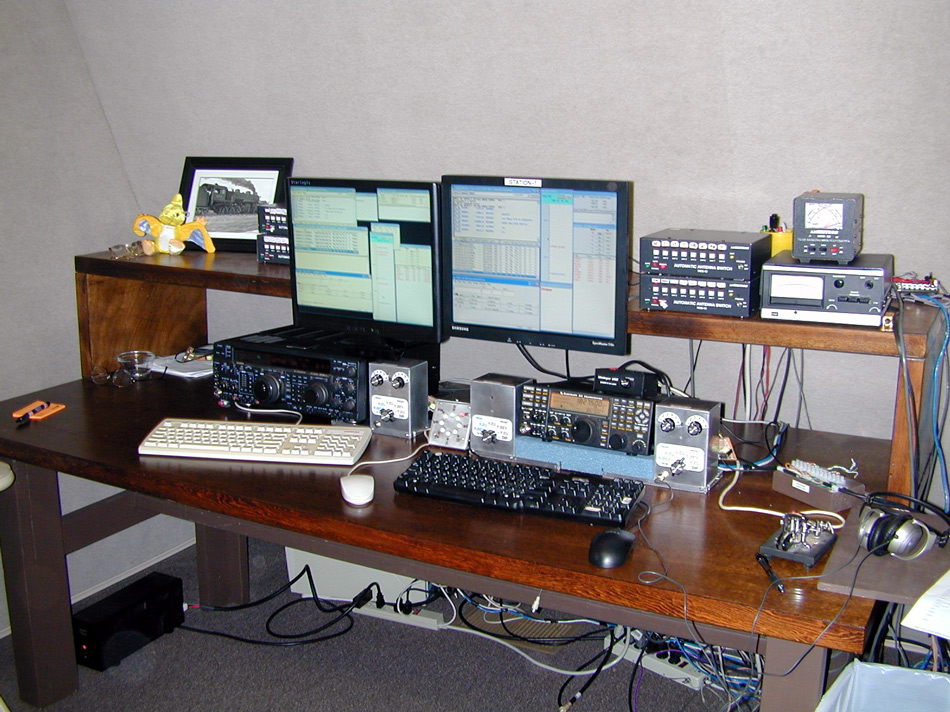
small boards have plugs that fit my RSC12 antenna switch and other
equipment. They connect through multiple conductor cables to larger terminal
hubs on movable boards that lay on the floor between desks. My control
wiring appears at multiple identical terminal blocks, appearing
terminal-for-terminal in the house and barn both. The large room block here
is hidden behind the trash can in the above picture, but you can see the
multiple cables running to and from it.
The RCS12 boxes have band decoders inside, lock out wrong-band antennas,
and have amplifier relay line lockout.
can quickly move receiving controls (aluminum boxes) from desk-to-desk,
because they just plug right into receiver functions. Headphones plug into
the aluminum boxes, where audio and receiving antennas are switched.
switch panels or antenna entrance connectors where they are easily moved.
blocks that lay between the desks or on walls downstairs. There is
minimal need to get behind radios, and there isn’t a great deal of confusing
desk wiring. 95% of any changes are either made downstairs on a wall panel,
or on movable terminal blocks that can be set right on a desk for wiring
changes. The only time I get under a desk is to change wires that drop over
for keyboards and monitors to the computer, or power supplies.
Transmitting
Antenna Matrix
The transmitting
antenna system is
being revised to the
following system:
W8JI Antenna
Matrix 9/12/09
|
Ant |
Tower |
remote relay |
feed+ control |
local relay |
Sub-local relay |
Control required |
|
160v |
200 |
8 Direction 4sq |
200/.5 2 +(3 BCD) |
2 of 8 |
2 of 4 |
5 (4sq controls) |
|
160 4sq |
|
|
||||
|
160 dip |
300
|
2 of 8 |
300 .625 300 7/8th 3bcd x2 12v x1 |
|
|
7 (2x bcd3 and
(note:3 spare |
|
Reserved Spare |
2 of 4 |
|
||||
|
80 Eu |
|
|
||||
|
80 JA |
|
|
||||
|
80 low |
rot |
2 of 8 |
rot .625 x3 |
|
|
12 (note: 3 |
|
80/40 curtain |
Direct barn |
N/A |
N/A |
|
|
0 |
|
40 Yagi |
rot |
|
2 stack, 4 min |
|
|
Stack 2 wire BCD
Rotor 4 |
|
40 Yagi (+4 extra) |
70 |
RCS-10 |
70 .875 |
|
|
3 (BCD) (4 ant spares) |
|
40 4sq |
barn |
|
vert 7/8th 4sq= 3 |
|
|
3 (4sq |
|
Aux dipole |
barn |
|
|
|
|
0 |
|
20 stack |
200 |
2 of 4 |
bridge .625 bridge .625 |
|
|
12 (2bcd +12v
Not installed |
|
20 yagi |
rot |
|
|
|
|
|
|
20 yagi |
70 |
|
|
|
|
|
|
15 stack |
200 |
|
2 bcd x3=6ant 6 for stack elv |
|
|
|
|
15 yagi |
rot |
|
|
|
|
|
|
15 yagi |
70 |
|
|
|
|
|
|
Reserved Spare |
300 |
|
|
|
|
|
|
10 stack |
200 |
|
|
|
|
|
|
10 yagi |
rot |
|
|
|
|
|
|
10 yagi |
70 |
|
|
|
|
|
Receiving
Antenna Switching
Matrix
The entire
receiving antenna
switching matrix was
assembled just hours
before the first 160-meter contest from
the new barn.
This switching
matrix allows any of
four receivers
(outputs on top) to
connect to any of
six antenna groups in any
combination. Most
antenna groups can
select multiple
directions at the
same time.

The following are critical construction techniques:
All input connectors mount directly to the input connector wall. Grounds do
NOT flow through wires or shield extensions.
Relays are dead-bug style, and use twisted pair wire busses instead of coax.
With this construction over the large copper foil PC board backplane, ingress
and egress from very strong signals is far into amplifier noise floor.
Cables are color coded by resistor color code sequence, and documented for
function and termination on a wire layout list.
One 75-ohm coaxial cable, a
CAT-5, and four CAT-3
cables go to each
receiver antenna and audio line switch position box. These boxes can be moved
around the room to any desk.
2007 CQWW 160
METER SINGLE OP
Callsign Used:
W4AN
Operator: N5OT
Bill Fisher, W4AN,
set an all-time CQWW 160
single-op record in 2004 at
W8JI. Bill
scored 753,867
points, with 1495
QSO’s in 56
US/Canada sections
and 67 countries.
That record was taken away in
2006 when N8T (K3BU at W8LRL) scored 776,424
points with 1464
contacts in 60
US/Canada sections
and 72 counties.
In memory of Bill, N5OT wanted to
bring the single-op
CQ160WW record back from W.Va. to
Georgia and W4AN.
The December ARRL 160 is always planned as an equipment and operator warm up session for the
January CQWW160. It was pretty tough getting ready for the 2006/7
contests. A
heavy work load and contest barn construction delays
prevented the new
contest station from
being ready for the
ARRL 160 contest.
Bad weather
prevented N5OT from
operating the ARRL
160 at the old W8JI
station, so Mark
missed the warm-up
where the operator becomes familiar with the station.
I
(W8JI) pecked away
at the keyboard,
mostly sending with a
paddle. Despite not being a particularly
proficient contest
op, I managed 444,528
points, with 1544 QSO’s and 126
multipliers, resulting in the top 2006 ARRL 160 CW contest score.
We were still
moving equipment
into
and wiring the new contest barn at the
start of the 2007 CQWW160 contest on
Friday of the contest. We did not have an
amplifier during much of the first few hours, and we experienced
several malfunctions
as the new station
was debugged. One of the worse failures occurred when a loose clamp on the
200-foot omni vertical transmitting antenna caused a catastrophic and
non-repairable failure in the 18-year old RCS-8V feeding all 160-meter antennas. This
knocked W4AN off the
air at a critical
hour. When the
antennas were
restored, another
failure forced
barefoot operation
through Sunday
morning peak hours. The
best receivers, a
pair of stereo
diversity phase-locked R4C’s with
double-balanced
diode solid-state mixers, were not available until the second night.
In spite of a few setbacks, Mark
piloted the
W4AN callsign to
840,486 points
with 1706 QSO’s in 58 sections and 69 countries. This was enough to soundly move
the 2007 CQWW 160 record back to Georgia and the
W4AN callsign.
Current Contest Barn Installation
Any operating position can access any antenna on any
radio in any
direction, and
select the audio
feed from any
receiver or (multiple)
receivers independently in each ear with stereo headphone jacks.

On
Top
From left to right:
Transmit antenna
switches for assist
or partner
Monitor for assist
or partner
Monitor for run
Run transmit antenna
selection
Rotating tower
control
Power meter
On
main desk level
Left radio
FT1000MKV. This
radio can transmit,
but is interlocked
with main radio. We
normally do not use
it to transmit.
Assist radio receiving
antenna and audio
selector
Receiving antenna
direction control
K3 sub-receiver
antenna selector
Elecraft K3
K3 main receiver
antenna and audio
selector
The receiving
antenna boxes can
pick up to six
different receiving
antenna groups or
systems. Most groups
or systems can pick
eight directions. It
also has a stereo
headphone jack, and
any receiver’s audio
can be placed on
either ear. We do NOT use the headphone jacks on radios. The radio speaker lines
all feed a transformer-isolated audio buss. This way any headset can listen to
any receiver in any ear. See
cables and wiring page
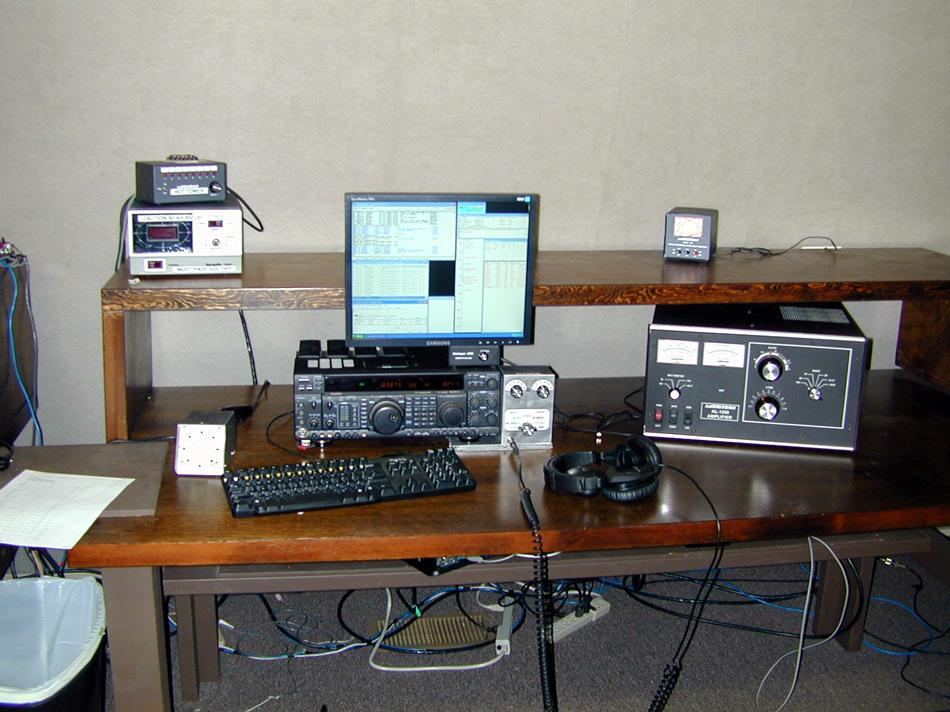
The multiplier
station is
interlocked. It
cannot transmit
while the run
station is on. It
can either use its
own transmitting
antennas, or it can
share the
transmitting
antennas of the run
station.
It has an identical
receive antenna box.
Six antenna groups
or systems are
available. As with
the run station, the
mult operator can
hear the audio of
any receiver in the
room in either ear.
The radio here is a
modified FT1000MP
MKV.
The multiplier
station has control
of the receive
directions for his
receiving antennas.
Floor vents below each desk blow
cool filtered air up
under the
desks. This helps
keep operators and
equipment cool.
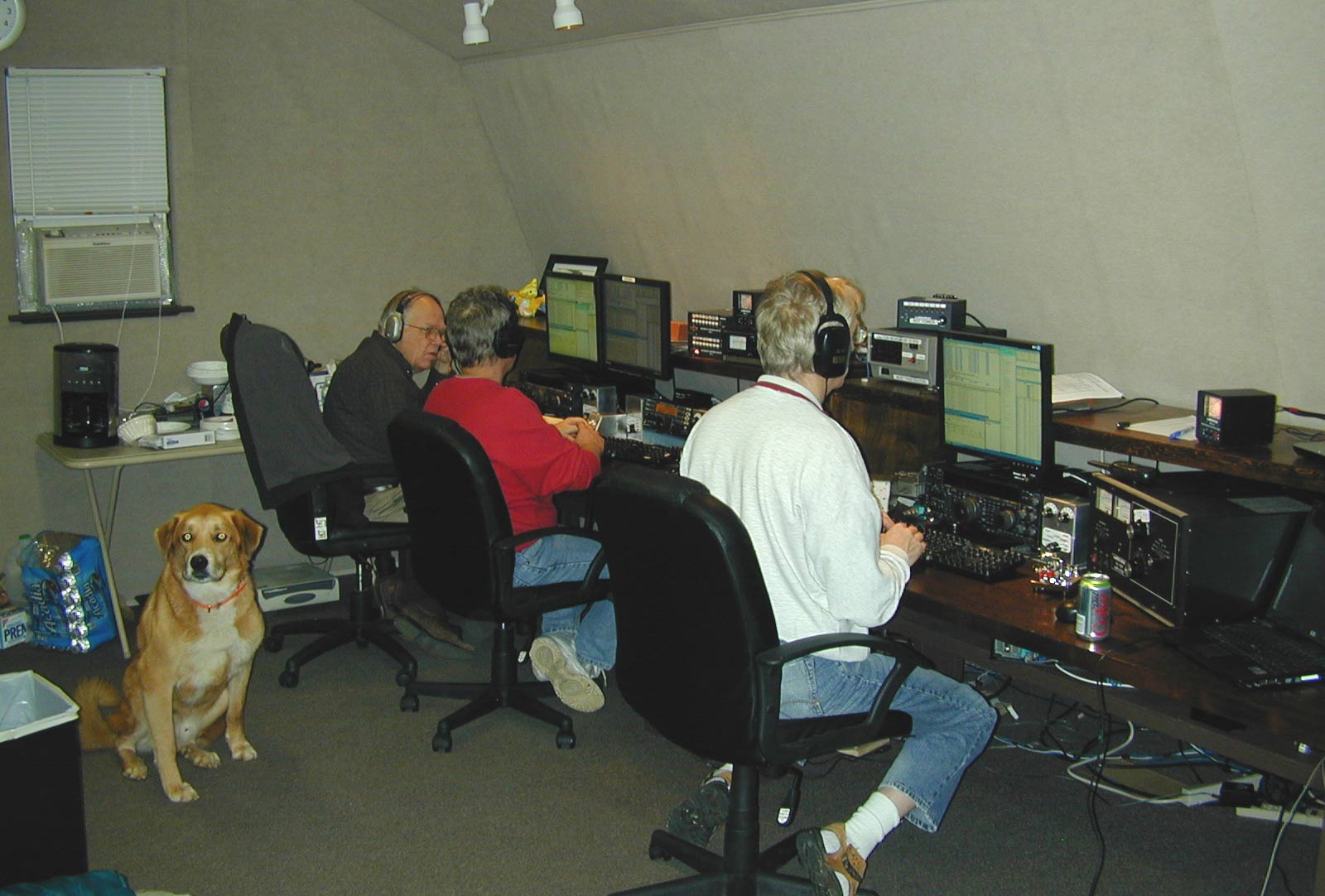
These are the ops
from one CQWW 160 CW
contest. From left
to right:
Hershey, he
cleans any spilled
snacks up.
John K4BAI
Dan K1TO
Jim VE7ZO
Our station was
the first USA to
ever score over one
million points in
any 160 contest, and
consistently places
first or second
place for USA locations.
We have set several
all time record
scores, including
40-meter single-band
records. This is
despite our inland
Georgia location and
~1,000 mile longer
path to Europe than
northeastern USA stations.
Although I’d rather live by the ocean, we do OK with Georgia clay, always in the
top one or two place position.
Rule #1 of contesting: Murphy was an Optimist
since 1/30/2007
